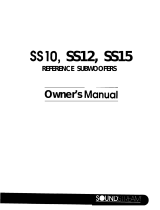
CONTROL FUNCTIONS
14. X-over mode and frequency Control (Monoblocks)
These controls allow control over the frequencies played for the rear channels.
There is an option for Low/BandPass, Full Range or High Pass. In HP mode, the frequency
range is from 15Hz to 500Hz. In LP mode, the frequency range can be switched from 50Hz
to 800Hz, or 250Hz to 4kHz. In the higher range, the LPF can be set at 4kHz for a midbass
while the front channels are also set at 4kHz for a tweeter resulting in a 2-way xover and
eliminating the need for a passive xover. Even with a set up like this, the midbass can still
be protected by the HPF which is not defeatable. It can be set anywhere in the 15Hz to
500Hz range creating a bandpass filter for the midbass by eliminating any damaging lower
frequencies in the subbass region.
15. Bass Boost Level switch
This switch can boost bass level by 0dB, 6dB or 12dB. The boost frequency is
centered at 50Hz.
16. Input mode switch
This function is for switching the rear channels' signal path. When switched to 4CH,
all 4 RCAs inputs are required. When switched to 2CH, the rear channels get their signal
input from the front channels in parallel.
17. Power Indicator
This LED will light up when amplifier works properly.
18. Protection Indicator
The red LED will light up and will be flashing if there is a fault presented to the
amplifier. Please disconnect the amplifier and resolve the fault before reconnecting the
amplifier.
INSTALLATION PRECAUTIONS
Before you install the amplifier, investigate your car's layout very carefully. Take
special care when you work near the gas tank, fuel lines, hydraulic lines and electrical
wiring. Before making or breaking power connections in your system, disconnect the

















